Check out the 22 projects just named winners of WoodWorks' 2023 Wood Design Awards
By Josh Niland|
Monday, Mar 27, 2023

Related
WoodWorks has announced the winners of the 2023 Wood Design Awards, an annual showcase of the industry’s most inspiring applications of mass timber and wood in building designs across the United States.
A total of 22 projects were selected in ten categories by a jury panel that included Hacker Architects Principal Corey Martin, Cheung Chan of the Iowa-based firm Neumann Monson Architects, and Arup Senior Structural Engineer Lauren Wingo.
The past year has seen an unprecedented rise in the use of mass timber and other sustainable wood materials, with the headline-making addition of Milwaukee’s 25-story Ascent Tower, which won in the Innovation category, to the global repository of high-rise architecture among the many noteworthy innovations.
"Investing in a more sustainable future deserves to be recognized. It’s an honor to celebrate design teams that inspire the broader AEC community by challenging the expectations of modern design and construction," WoodWorks President and CEO Jennifer Cover said at the announcement. "This year's winning projects represent the work of building designers from across the nation who are demonstrating the incredible potential of wood. From 19 stories of CLT and glulam towering over the Milwaukee skyline to wooden reflectors enhancing acoustics in a Colorado theater, these projects underscore how wood enriches the physical landscape of our communities and the experience of those who inhabit them."
Scroll down to see WoodWorks' selection of award-winning projects.
COMMERCIAL WOOD DESIGN – MID-RISE
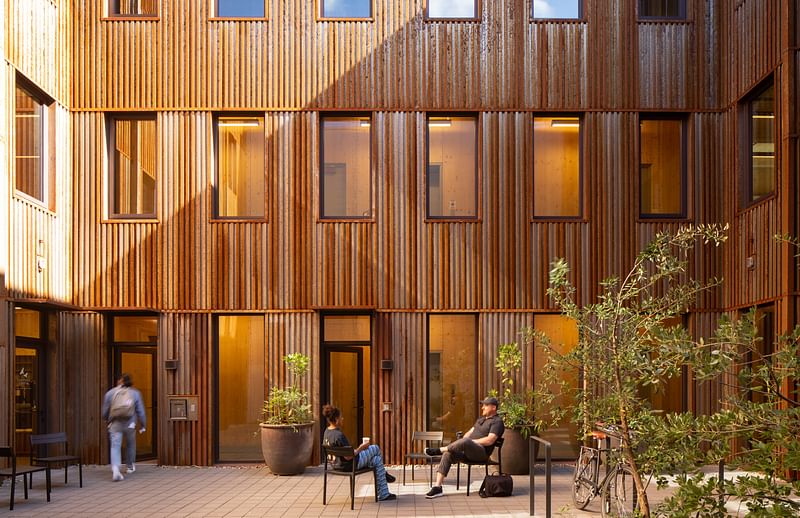
Mississippi Workshop
Portland, OR
Architect: Waechter Architecture
Description: "Located on a busy commercial street, Mississippi Workshop was designed as a prototype for
new sustainable building systems and construction technologies. Adaptive
, durable and
beautiful, it reinterprets and updates the classic industrial loft typology for the 21st
Century.
Mass timber was used for all primary components of the structure and spatial
definition, without the need for additional fireproofing or interior finishes. The building is
comprised of six equal spaces stacked in three tiers on opposite sides of a shared courtyard,
which serves as a multipurpose gathering space and transition from the busy street. Its
configuration, materials, and building systems were designed to respond to a range of contexts
and potential uses; the current programming includes a café, wood shop, creative offices, and
top-floor apartment.
Last year, the Waechter-led team
received a USDA Wood Innovations
Grant to study and share findings on the project’s performance, and identify potential
applications for its innovative approach in other commercial, institutional, and residential
settings."
COMMERCIAL WOOD DESIGN – LOW-RISE
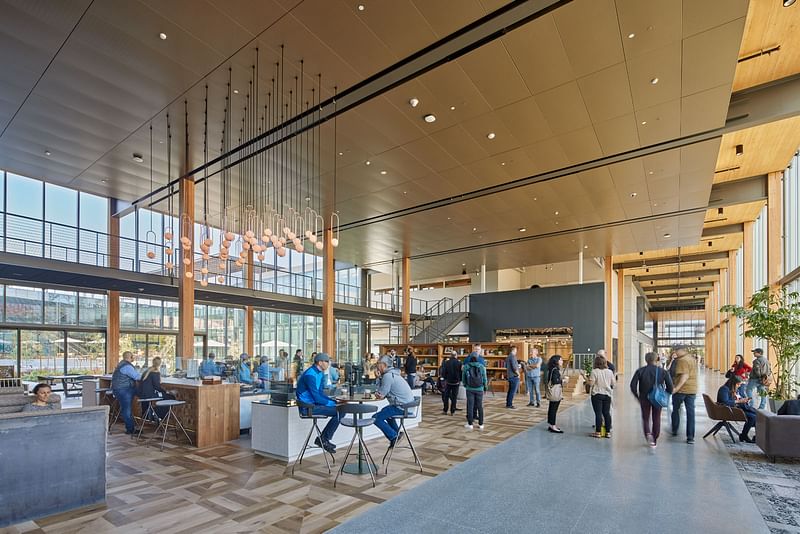
High Tech Client Campus
Mountain View, CA
Architect: WRNS Studio
Description: "When a high tech company decided to use mass timber for a new building on their Silicon Valley campus, the company’s commitment to fostering a deeply sustainable workplace overshadowed the challenges posed by the lack of detailed provisions in the building code at the time. This required that the design and engineering team work closely with code officials over the project’s six-year duration. The building features a hybrid design that combines CLT-concrete composite floors with glulam columns, steel beams, and concrete shear walls. The composite floor system allowed the CLT panels to span further, creating a more open interior, and the concrete topping also concealed power and data systems. The two-story mass timber structure was designed to target LEED Platinum, Net Zero Water, and Well Building Standard certifications. The design team estimates that their decision to use mass timber for the new building yielded an estimated structural embodied carbon savings of 36%. Overall, mass timber accounts for more than half the structural components in the three-building, 2,000-employee campus."
WOOD IN SCHOOLS

San Jacinto College Anderson-Ball Classroom Building
Pasadena, TX
Architect: Kirksey Architecture
Description: "San Jacinto College introduced mass timber to Houston area students in dramatic fashion whenthey constructed this building using exposed glulam columns and beams and CLT panels. The three-story structure features 56 classrooms, a robotics lab, and lecture halls; it also includes formal and informal study and hang-out spaces, tucked away in traditionally underutilized nichesand corridors. Wood makes a clear statement as students enter the building through a striking two-story lobby, designed with a double glulam column and beam configuration that also conceals sprinkler lines and electrical conduits. Due to the lighter weight of wood construction, designers were able to reuse portions of the foundation in the building being replaced—a 1950s-era classroom building—saving the San Jacinto College District time and money. The College has since used this project as a platform to promote the use of mass timber in the Gulf Coast region by hosting a series of mass timber conference."
MULTI-FAMILY WOOD DESIGN
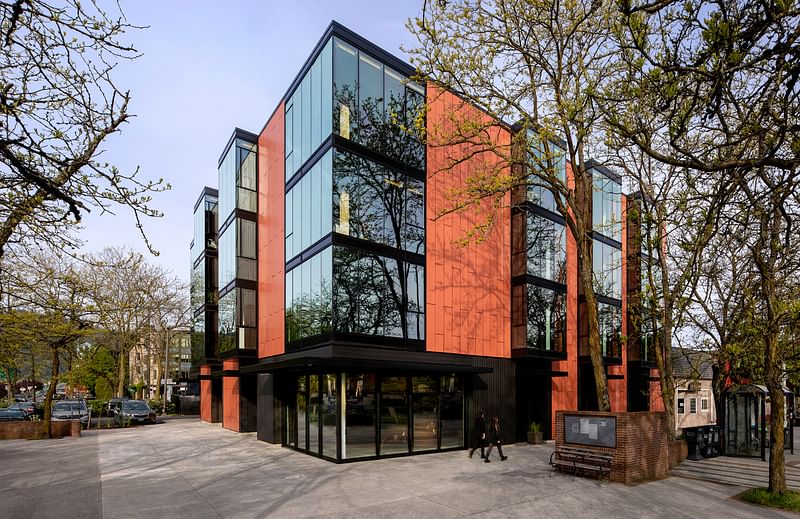
Central Lofts
Portland, OR
Architect: Jones Architecture
Description: "Central Lofts was among the pioneers of mass timber multi-family developments in the City of Portland. Located at the base of the iconic St. Johns Bridge, the four-story, 30-unit building takes full advantage of its charismatic neighborhood and prominent location next to a plaza, which sits at the center of the area’s commercial corridor. Because designers wanted to minimize the use of steel and concrete yet provide a flexible ground-story layout, the CLT and glulam structure is combined with exterior wood shear walls. This wood exoskeleton is paired with a central scissor stair made of two interlocking CLT stair systems, which provide shear stability and optimize the building’s footprint by minimizing circulation area. With floor-to-ceiling glazing that provides views into neighboring Forest Park, the bright, airy apartment units are awash with natural light, highlighting the exposed wood beams and ceilings while promoting resident well-being."
WOOD IN GOVERNMENT BUILDINGS
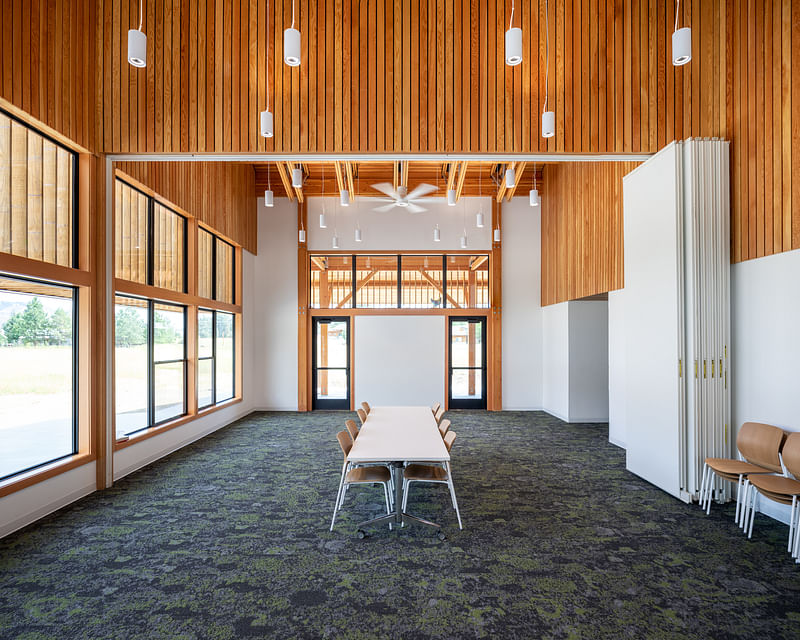
Winthrop Libray
Winthrop, WA
Architect: Johnston Architects; Prentiss Balance Wickline
(associate architects)
Description: "Most of the funding for this new library, built on the former site of a trading post and lending library tracing back to 1898, came via private donations from the small yet engaged Winthrop community. Replacing two smaller libraries, one of which supports almost 30 book clubs, the new light-filled structure provides meeting and library space for the area’s diverse users. Layout for the rectangular structure centers on two axes—the north/south axis follows the nearby Methow River and the east/west axis points toward Gardner Mountain. Inspired by the community’s love of agrarian buildings, the design features glulam columns and exposed open-web wood and steel trusses. The prefabricated trusses reduced material costs, shortened the construction schedule, and provided a finish that fit with other historic wood-frame buildings in the area. Wood baffles line the walls and ceiling, forming sound-absorbent surfaces that diffuse ambient noise to create a comfortable environment. Built on a tight budget and designed to LEED Silver, the library reflects both the ecological and fiscal values of its patrons and community."
INSTITUTIONAL WOOD DESIGN
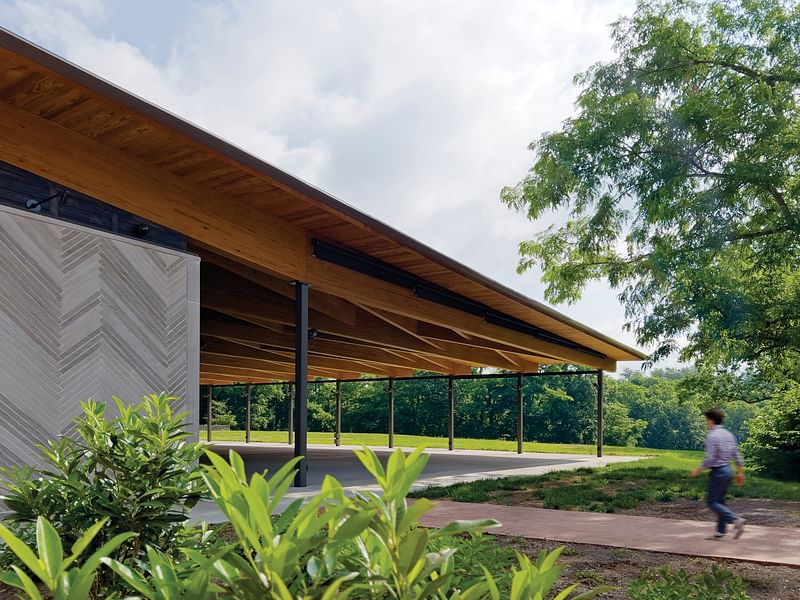
Locust Grove Event Pavilion
Louisville, KY
Architect: de Leon & Primmer Architecture Workshop
Description: "This open-air pavilion takes full advantage of its beautiful location, a 55-acre, 18th-century farm that was once home to the founder of nearby Louisville. Inspired by the property’s collection of historic buildings, the design emulates the porches of Georgian farmhouses, combining limestone walls with a low-slung glulam roof canopy that minimizes visual impact on the landscape while providing unobstructed views. Despite a modest budget, the project presents a high degree of detail. Profiled glulam beams are infilled with decorative secondary framing to create a coffered ceiling that mimics the intertwined branches and sinewy texture of black locusttree bark, the property’s namesake. A popular event space, the pavilion holds musical performances, weddings, and galas for up to 350 people, and the coffered ceiling also helps reduce noise. The limestone walls are set in a herringbone pattern that evokes patterns and hand-laid stonework of the ‘ha-ha’ walls and split-rail fences that surround the property."
SUSTAINABLE WOOD DESIGN
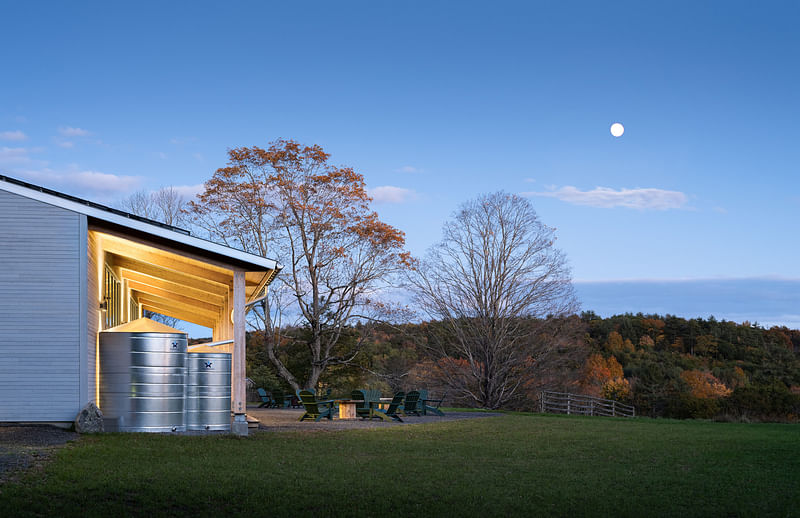
The Ecology School
Seco, ME
Architect: Simons Architects; Kaplan Thompson, and Briburn Architecture
Description: "This non-profit residential learning center works to link human and natural systems through immersive learning experiences for children and adults, making the purposeful use of wood construction and finish materials a natural choice. Designed through a unique three-firm architectural collaboration, it includes a dining commons and three two-story dormitories made from a mix of mass timber and light-frame wood construction. The team used wood to meet boththe school’s embodied carbon goal and strict requirements of the Living Building Challenge (LBC), one of the most rigorous measures of social and environmental performance in the built environment. They reduced embodied carbon by using local, renewable materials, including FSC-certified New England wood, and accounted for the project’s total embodied carbon impactthrough a one-time carbon offset within the property’s boundary. The Ecology School is Net Zero Energy, Net Zero Water, and built to Passive House standards."
BEAUTY OF WOOD
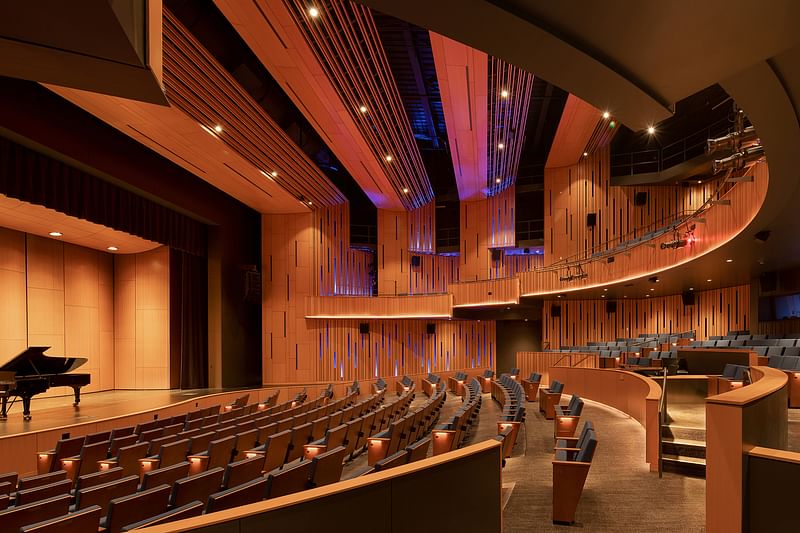
Patricia Reser Center for the Arts
Beaverton, OR
Architect: Opsis Architecture
Description: "The Reser serves as a beautiful example of how biophilic design and natural woodwork can be used to connect a performing and visual arts facility to its Pacific Northwest environment. When the City of Beaverton requested that wood be used in public interior spaces, Opsis answered with designs that provided both highly-engineered acoustic performance and artistic expression.Locally sourced Douglas fir—layered sticks and panels in the lobby and vertical cutouts and folds in the theater—creates a complex, ordered pattern that seamlessly integrates acoustical and theatrical systems. The theater’s embracing wood enclosure and performance-based geometry create an intimate relationship between audience and performers. In the lobby, the play of natural light through a linear skylight strategically placed across the interior wall is dynamic and diffuse, evoking the organic crisscross of a beaver dam’s woven structure within this visually calming community space. The lobby’s expansive two-story wood and glass curtain wall presents the Center’s rich wood interior to the surrounding community as a warm and inviting beacon to the arts."
DURABLE AND ADAPTABLE WOOD STRUCTURES
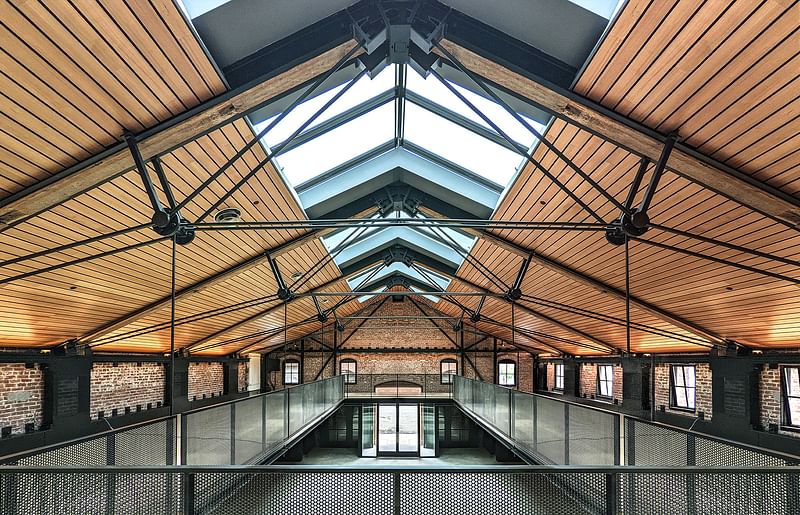
Maclac Building D
San Francisco, CA
Architect: Marcy Wong Donn Logan Architects and Peter Logan Architecture and Design (PLAD)
Description: "This innovative LEED Gold-certified project involved the adaptive reuse of an historic lacquer and paint factory in San Francisco’s warehouse district. The edifice—Building D in a complex of alphabetically named structures—is representative of San Francisco's post-1906 earthquake industrialization.Retaining the original brick shell, new steel king post trusses were nestled against the original heavy timber roof beams, allowing the team to level the old roof while protecting the building’s geometry. Wood was essential to the interior's transformation from a cold, earthquake-vulnerable shell to a seismically-upgraded, visually warm and inviting space.CLT diaphragms suspended from trusses were crucial to the seismic upgrade, whilecreating valuable floor space with exceptional vantage points of the building volume, and allowing a column-free lower level. The roof is reframed above the reconfigured trusses with light-frame wood construction, accommodating a continuous ridge skylight with integrated plywood shear panels."
INNOVATION
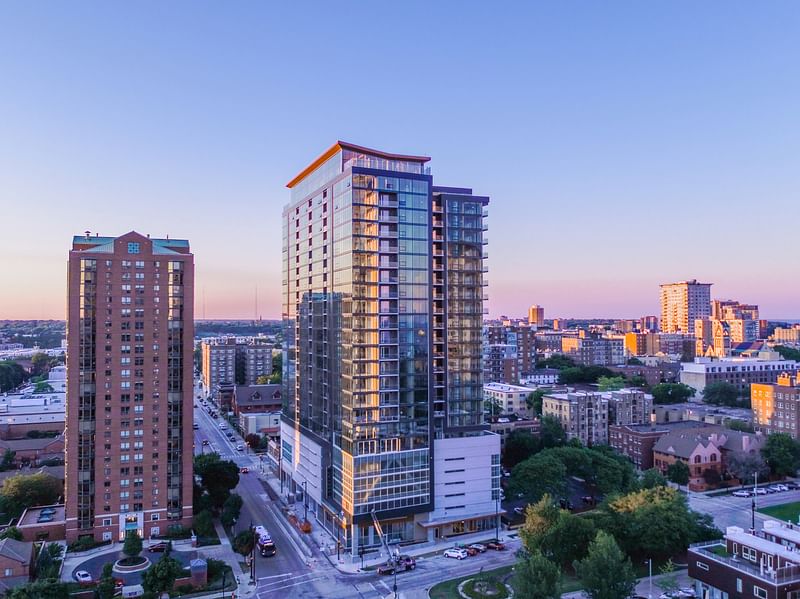
Ascent Tower
Milwaukee, WI
Architect: Korb + Associates Architects
Description: "Aptly named, this 25-story hybrid tower took mass timber higher than it had ever gone. With 19 stories of CLT and glulam over a six-story concrete podium, Ascent placed 259 apartments and amenity spaces in the heart of downtown Milwaukee, making a mass timber statement for all to see. The team chose timber with sustainability, carbon, and biophilia in mind, exposing about 50% of the wood throughout to help curb stress and boost well-being. To demonstrate fire safety, they worked with USDA's Forest Products Laboratory to complete the world's first 3-hourglulam fire test. The building sequesters approximately 7,200 metric tons of CO2, equivalent to taking 2,400 cars off the road for a year, and the volume of wood used takes estimated 25 minutes to grow in North American forests. The project took just two years to build,reducing the schedule by several months compared to other building systems. Ascent gave mass timber construction worldwide attention, illuminating both short- and long-term opportunities for sustainable building design."
REGIONAL EXCELLENCE
INTRO
Cleveland, OH
Architect: Hartshorne Plunkard Architecture
Idaho Central Credit Union Arena
Moscow, ID
Architect: Opsis Architecture; Hastings+Chivetta Architects
1030 Music Row
Nashville, TN
Architect: Anecdote Architectural Experience
80 M Street
Washington, D.C.
Architect: Hickok Cole
Chemeketa Community College Agricultural Complex
Location: Salem, OR
Architect: FFA Architecture and Interiors
Wellesley College Science Complex
Wellesley, MA
Architect: Skidmore, Owings & Merrill
Nanotronics Smart Factory
Brooklyn, NY
Architect: Rogers Partners
Kansas City Current Training Facility
Riverside, MO
Architect: Generator Studio
Houston Endowment Headquarters
Houston, TX
Architect: kevin daly Architects with Productura
Ellis Golf Course Clubhouse
Cedar Rapids, IA
Architect: OPN Architects
Crested Butte Center for the Arts
Crested Butte, CO
Architect: Steinberg Hart with Andrew Hadley Architect
316 12
th
Street
Oakland, CA
Architect: oWOW Design

RELATED NEWS Technical innovation and beauty present amongst 2022 Wood Design Awards winners

RELATED NEWS Winners of the 2022 Timber in the City competition showcase wood design in architecture


Share
0 Comments
Comment as :